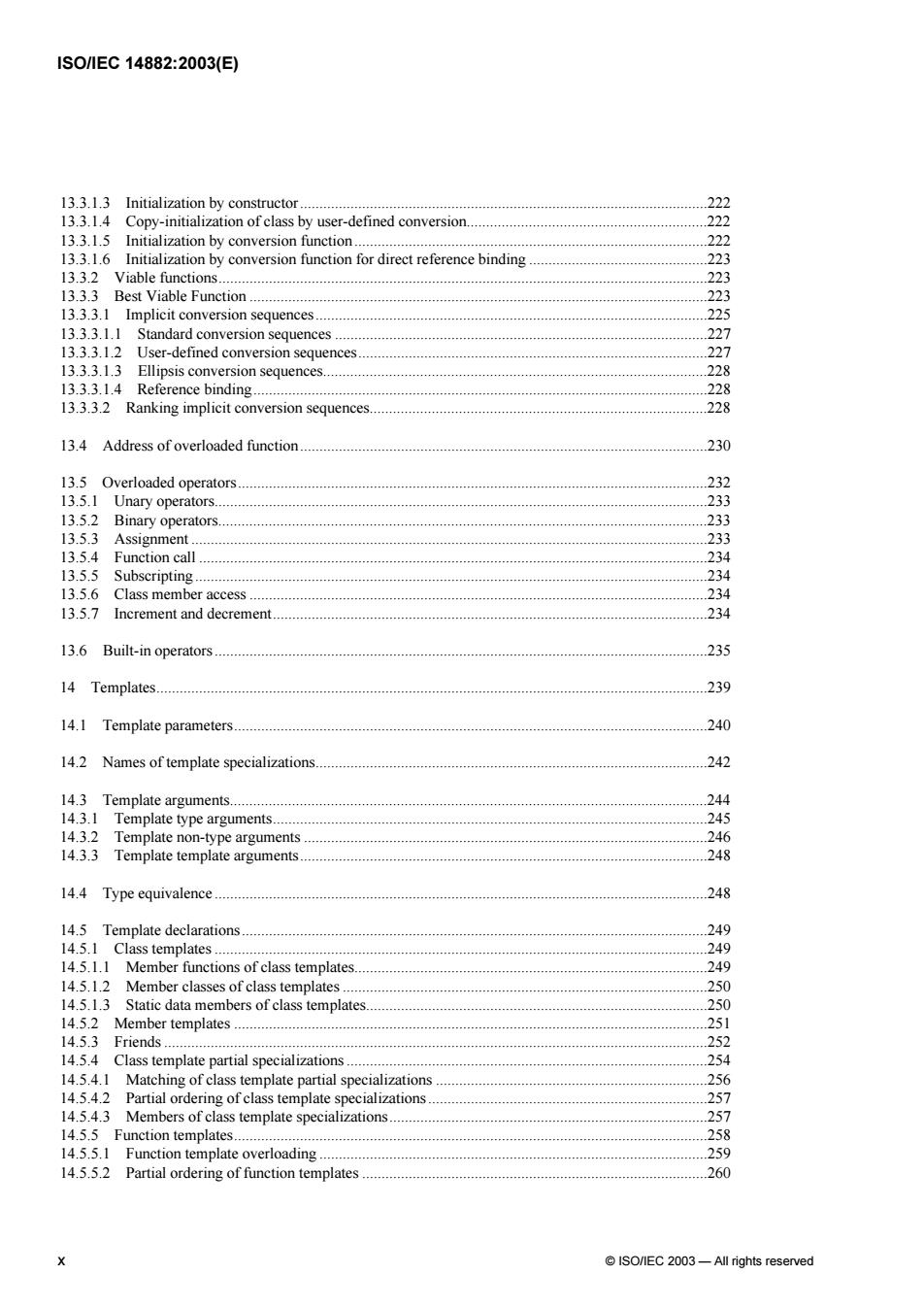正在加载图片...

1S01EC148822003(E) 13.3.1.3 Initialization by constructor. 222 13.3.14 Copy-initialization ofelass by user-defined conversion 222 133.15 Intialization by conversion function.......... 222 13.3.16 Initialization by conversion function for direct reference binding. 223 13.3.2 Viable functions 223 13.3.3 Best Viable Function 223 13.3.3.1 Implicit conversion sequences.. 225 13.33.1.1 Standard conversion sequences 227 13.3.3.1 2 User-defined conversion sequences......... 227 13.3.3.1.3 Ellipsis comversion sequences............. 228 13.3.3.1.4 Reference binding 228 13.3.3.2 Ranking implicit coemversion sequences 228 13.4 Address of overloaded function. 230 13.5 Overloaded operators. 232 13.5.1 Unary operators.. 233 13.5.2 Binary operators. 233 13.5.3 Assignment 233 13.5.4 Function call 234 13.5.5 Subscnpeing...... 234 13.56 Class member access. 234 13.5.7 Increment and deeremen 234 136Bun业-operators 235 14 Templates. 239 14.1 Template parameters. 240 14.2 Names of template specializntions. 242 14.3 Template arguments. 244 14.3.1 Template type arguments 245 14.3.2 Template noe-type arguments 246 14.3.3 Template template arguments. 248 14.4 Type equivalence. 248 14.5 Template declarations. 249 14.5.1 Class templaces 249 14.5.1.1 Member functions of class templates......... 249 14 5.1 2 Member classes of class templales.... 250 14.5.1.3 Static data members of class templates..... 250 14.5.2 Member templales 中年年车中年年4444411年44111车4年车44年 251 14.5.3 Friends ....... 252 14.54 Class template partial specializations. 254 14.54.1 Matching of class template partial specializations 256 14.5.4.2 Partial ordering of elass template specializations 44444444444444444444444444 257 14.5.4.3 Members of class template specializations 257 14.5.$Function templates 258 14.5.5.1 Function template overloading 259 14.5.5.2 Partial ordering of function templaes..... 260 SOMEC 2003-Al rights neserved ISO/IEC 14882:2003(E) x © ISO/IEC 2003 — All rights reserved 13.3.1.3 Initialization by constructor .........................................................................................................222 13.3.1.4 Copy-initialization of class by user-defined conversion..............................................................222 13.3.1.5 Initialization by conversion function ...........................................................................................222 13.3.1.6 Initialization by conversion function for direct reference binding ..............................................223 13.3.2 Viable functions ..............................................................................................................................223 13.3.3 Best Viable Function ......................................................................................................................223 13.3.3.1 Implicit conversion sequences .....................................................................................................225 13.3.3.1.1 Standard conversion sequences ................................................................................................227 13.3.3.1.2 User-defined conversion sequences ..........................................................................................227 13.3.3.1.3 Ellipsis conversion sequences...................................................................................................228 13.3.3.1.4 Reference binding .....................................................................................................................228 13.3.3.2 Ranking implicit conversion sequences.......................................................................................228 13.4 Address of overloaded function .........................................................................................................230 13.5 Overloaded operators .........................................................................................................................232 13.5.1 Unary operators...............................................................................................................................233 13.5.2 Binary operators..............................................................................................................................233 13.5.3 Assignment .....................................................................................................................................233 13.5.4 Function call ...................................................................................................................................234 13.5.5 Subscripting ....................................................................................................................................234 13.5.6 Class member access ......................................................................................................................234 13.5.7 Increment and decrement ................................................................................................................234 13.6 Built-in operators ...............................................................................................................................235 14 Templates ..............................................................................................................................................239 14.1 Template parameters ..........................................................................................................................240 14.2 Names of template specializations .....................................................................................................242 14.3 Template arguments...........................................................................................................................244 14.3.1 Template type arguments ................................................................................................................245 14.3.2 Template non-type arguments ........................................................................................................246 14.3.3 Template template arguments .........................................................................................................248 14.4 Type equivalence ...............................................................................................................................248 14.5 Template declarations ........................................................................................................................249 14.5.1 Class templates ...............................................................................................................................249 14.5.1.1 Member functions of class templates...........................................................................................249 14.5.1.2 Member classes of class templates ..............................................................................................250 14.5.1.3 Static data members of class templates........................................................................................250 14.5.2 Member templates ..........................................................................................................................251 14.5.3 Friends ............................................................................................................................................252 14.5.4 Class template partial specializations .............................................................................................254 14.5.4.1 Matching of class template partial specializations ......................................................................256 14.5.4.2 Partial ordering of class template specializations ........................................................................257 14.5.4.3 Members of class template specializations ..................................................................................257 14.5.5 Function templates ..........................................................................................................................258 14.5.5.1 Function template overloading ....................................................................................................259 14.5.5.2 Partial ordering of function templates .........................................................................................260